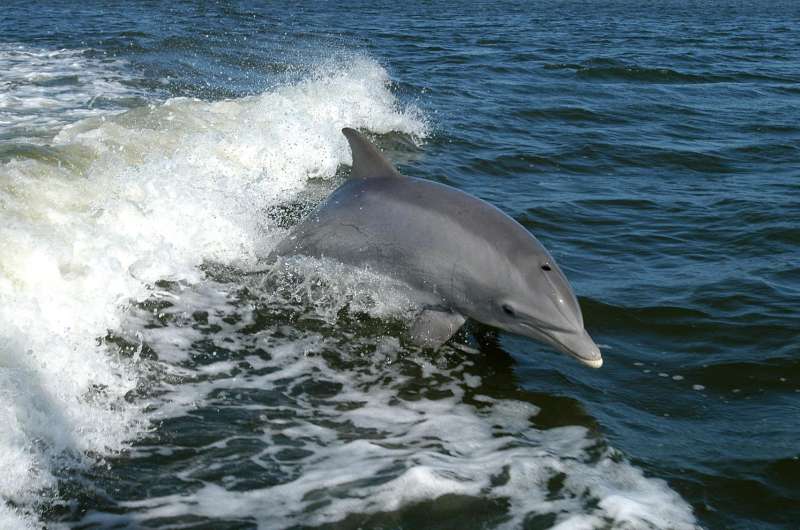January 17, 2018 report
Measuring metabolism in dolphins to calculate their caloric needs

A team of researchers from several institutions in the U.S. and one in Spain has measured the metabolism of wild bottlenose dolphins in an effort to better understand their caloric needs. In their paper published in the journal Royal Society Open Science, the group describes measuring the dolphins, what they found, and explain how their findings can help with conservation efforts.
Climate change is expected to have an impact on wildlife across the globe. As temperatures creep upward, researchers study various species to better understand how this might affect them. In this new effort, the researchers sought to learn more about the food intake needs of bottlenose dolphins living off the coast of Florida in Sarasota Bay.
To understand how much food a wild dolphin requires to live, the team looked at ocean temperatures, various states of dolphin activity and most particularly at the dolphins themselves. They noted that dolphins, like other mammals, require energy to fuel brain activity and to keep up with busy muscles—and also to keep warm. Because of this, they require different amounts of food depending on how active they are and how cold the water is.
To calculate the caloric needs of the dolphins, the researchers started with data from prior studies, which have shown that the daily metabolic rate for many species averages out to approximately three to six times that of their resting rate. For the dolphins, that meant capturing several specimens and measuring their metabolic rate while they were kept at rest and then multiplying by three to six to get their average rates.
The team reports that they found that the dolphins under study (with an average weight of 200 kg) required approximately 16,500 to 33,000 calories each day, which they further note translated to approximately 10 to 25 kg of fish each day. As part of the study, the group also tested lung function in the dolphins, which has been found to be a marker of environmental health in marine species.
The researchers suggest studies like theirs will help with conservation efforts as the planet changes—if dolphins begin to require less food, for example, due to warmer water, that could lead to an increase in fish populations.
More information: A. Fahlman et al. Field energetics and lung function in wild bottlenose dolphins, Tursiops truncatus , in Sarasota Bay Florida, Royal Society Open Science (2018). DOI: 10.1098/rsos.171280
Abstract
We measured respiratory flow rates, and expired O2 in 32 (2–34 years, body mass [Mb] range: 73–291 kg) common bottlenose dolphins (Tursiops truncatus) during voluntary breaths on land or in water (between 2014 and 2017). The data were used to measure the resting O2 consumption rate (V˙O2V˙O2, range: 0.76–9.45 ml O2 min−1 kg−1) and tidal volume (VT, range: 2.2–10.4 l) during rest. For adult dolphins, the resting VT, but not V˙O2V˙O2, correlated with body mass (Mb, range: 141–291 kg) with an allometric mass-exponent of 0.41. These data suggest that the mass-specific VT of larger dolphins decreases considerably more than that of terrestrial mammals (mass-exponent: 1.03). The average resting sV˙O2sV˙O2 was similar to previously published metabolic measurements from the same species. Our data indicate that the resting metabolic rate for a 150 kg dolphin would be 3.9 ml O2 min−1 kg−1, and the metabolic rate for active animals, assuming a multiplier of 3–6, would range from 11.7 to 23.4 ml O2 min−1 kg−1.absbreak Our measurements provide novel data for resting energy use and respiratory physiology in wild cetaceans, which may have significant value for conservation efforts and for understanding the bioenergetic requirements of this species.
Journal information: Royal Society Open Science
© 2018 Phys.org



















